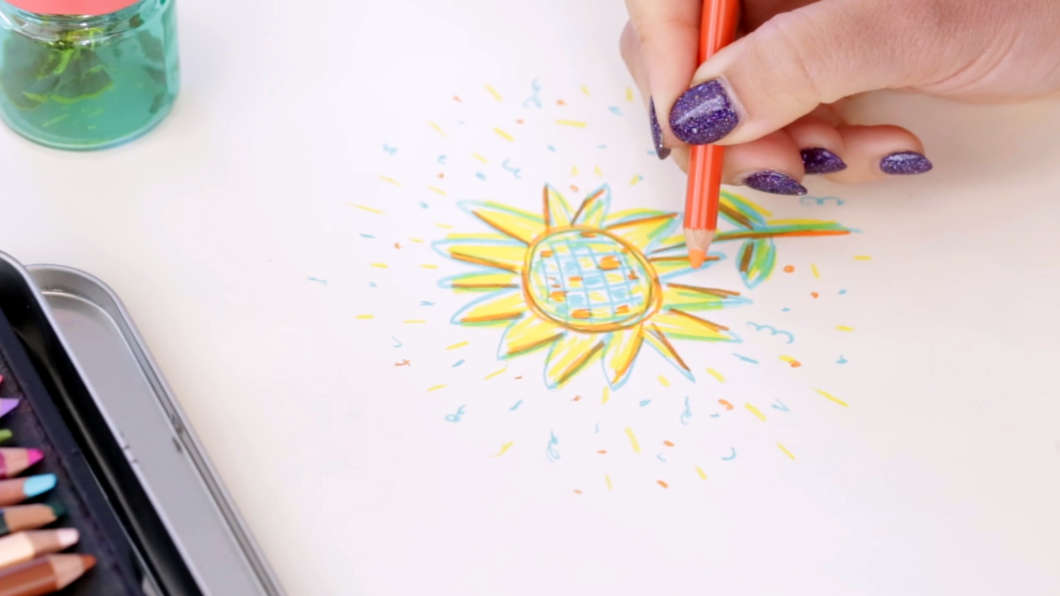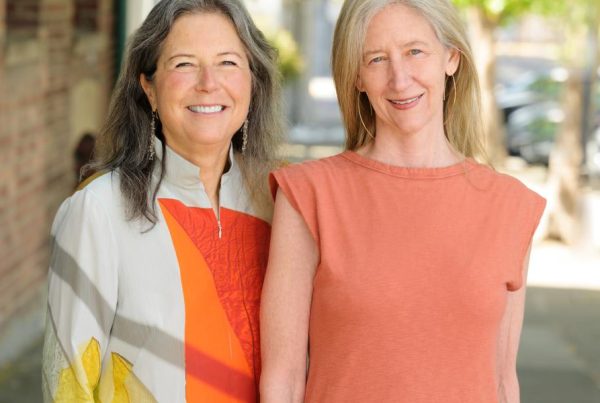Making art is fun. But there’s a lot more to it. It might serve an evolutionary purpose — and emerging research shows that it can help us feel happy and relaxed.
A lot of my free time is spent doodling. I’m a journalist on NPR’s science desk by day. But all the time in between, I am an artist — specifically, a cartoonist.
I draw in between tasks. I sketch at the coffee shop before work. And I like challenging myself to complete a zine — a little magazine — on my 20-minute bus commute.
I do these things partly because it’s fun and entertaining. But I suspect there’s something deeper going on. Because when I create, I feel like it clears my head. It helps me make sense of my emotions. And it somehow, it makes me feel calmer and more relaxed.
That made me wonder: What is going on in my brain when I draw? Why does it feel so nice? And how can I get other people — even if they don’t consider themselves artists — on the creativity train?
It turns out there’s a lot happening in our minds and bodies when we make art.
“Creativity in and of itself is important for remaining healthy, remaining connected to yourself and connected to the world,” says Christianne Strang, a professor of neuroscience at the University of Alabama Birmingham and the former president of the American Art Therapy Association.
This idea extends to any type of visual creative expression: drawing, painting, collaging, sculpting clay, writing poetry, cake decorating, knitting, scrapbooking — the sky’s the limit.
“Anything that engages your creative mind — the ability to make connections between unrelated things and imagine new ways to communicate — is good for you,” says Girija Kaimal. She is a professor at Drexel University and a researcher in art therapy, leading art sessions with members of the military suffering from traumatic brain injury and caregivers of cancer patients.
But she’s a big believer that art is for everybody — and no matter what your skill level, it’s something you should try to do on a regular basis. Here’s why:
It helps you imagine a more hopeful future
Art’s ability to flex our imaginations may be one of the reasons why we’ve been making art since we were cave-dwellers, says Kaimal. It might serve an evolutionary purpose. She has a theory that art-making helps us navigate problems that might arise in the future. She wrote about this in October in the Journal of the American Art Therapy Association.
Her theory builds off of an idea developed in the last few years — that our brain is a predictive machine. The brain uses “information to make predictions about we might do next — and more importantly what we need to do next to survive and thrive,” says Kaimal.
When you make art, you’re making a series of decisions — what kind of drawing utensil to use, what color, how to translate what you’re seeing onto the paper. And ultimately, interpreting the images — figuring out what it means.
“So what our brain is doing every day, every moment, consciously and unconsciously, is trying to imagine what is going to come and preparing yourself to face that,” she says.
Kaimal has seen this play out at her clinical practice as an art therapist with a student who was severely depressed. “She was despairing. Her grades were really poor and she had a sense of hopelessness,” she recalls.
The student took out a piece of paper and colored the whole sheet with thick black marker. Kaimal didn’t say anything.
“She looked at that black sheet of paper and stared at it for some time,” says Kaimal. “And then she said, ‘Wow. That looks really dark and bleak.’ ”
And then something amazing happened, says Kaimal. The student looked around and grabbed some pink sculpting clay. And she started making … flowers: “She said, you know what? I think maybe this reminds me of spring.”
Through that session and through creating art, says Kaimal, the student was able to imagine possibilities and see a future beyond the present moment in which she was despairing and depressed.
“This act of imagination is actually an act of survival,” she says. “It is preparing us to imagine possibilities and hopefully survive those possibilities.”
It activates the reward center of our brain
For a lot of people, making art can be nerve-wracking. What are you going to make? What kind of materials should you use? What if you can’t execute it? What if it … sucks?
Studies show that despite those fears, “engaging in any sort of visual expression results in the reward pathway in the brain being activated,” says Kaimal. “Which means that you feel good and it’s perceived as a pleasurable experience.”
She and a team of researchers discovered this in a 2017 paper published in the journal The Arts in Psychotherapy. They measured blood flow to the brain’s reward center, the medial prefrontal cortex, in 26 participants as they completed three art activities: coloring in a mandala, doodling and drawing freely on a blank sheet of paper. And indeed — the researchers found an increase in blood flow to this part of the brain when the participants were making art.
This research suggests making art may have benefit for people dealing with health conditions that activate the reward pathways in the brain, like addictive behaviors, eating disorders or mood disorders, the researchers wrote.
It lowers stress
Although the research in the field of art therapy is emerging, there’s evidence that making art can lower stress and anxiety. In a 2016 paper in the Journal of the American Art Therapy Association, Kaimal and a group of researchers measured cortisol levels of 39 healthy adults. Cortisol is a hormone that helps the body respond to stress.
They found that 45 minutes of creating art in a studio setting with an art therapist significant lowered cortisol levels.
The paper also showed that there were no differences in health outcomes between people who identify as experienced artists and people who don’t. So that means that no matter your skill level, you’ll be able to feel all the good things that come with making art.
It lets you focus deeply
Ultimately, says Kaimal, making art should induce what the scientific community calls “flow” — the wonderful thing that happens when you’re in the zone. “It’s that sense of losing yourself, losing all awareness. You’re so in the moment and fully present that you forget all sense of time and space,” she says.
And what’s happening in your brain when you’re in flow state? “It activates several networks including relaxed reflective state, focused attention to task and sense of pleasure,” she says. Kaimal points to a 2018 study published in the journal Frontiers in Psychology, which found that flow was characterized by increased theta wave activity in the frontal areas of the brain — and moderate alpha wave activities in the frontal and central areas.
So what kind of art should you try?
Some types of art appear to yield greater health benefits than others.
Kaimal says modeling clay, for example, is wonderful to play around with. “It engages both your hands and many parts of your brain in sensory experiences,” she says. “Your sense of touch, your sense of three-dimensional space, sight, maybe a little bit of sound — all of these are engaged in using several parts of yourself for self-expression, and likely to be more beneficial.”
A number of studies have shown that coloring inside a shape — specifically a pre-drawn geometric mandala design — is more effective in boosting mood than coloring on a blank paper or even coloring inside a square shape. And one 2012 study published in Journal of the American Art Therapy Association showed that coloring inside a mandala reduces anxiety to a greater degree compared to coloring in a plaid design or a plain sheet of paper.
Strang says there’s no one medium or art activity that’s “better” than another. “Some days you want to may go home and paint. Other days you might want to sketch,” she says. “Do what’s most beneficial to you at any given time.”
Process your emotions
It’s important to note: if you’re going through serious mental health distress, you should seek the guidance of a professional art therapist, says Strang.
However, if you’re making art to connect with your own creativity, decrease anxiety and hone your coping skills, “by all means, figure out how to allow yourself to do that,” she says.
Just let those “lines, shapes and colors translate your emotional experience into something visual,” she says. “Use the feelings that you feel in your body, your memories. Because words don’t often get it.”
Her words made me reflect on all those moments when I reached into my purse for my pen and sketchbook. A lot of the time, I was using my drawings and little musings to communicate how I was feeling. What I was doing was helping myself deal. It was cathartic. And that catharsis gave me a sense of relief.
A few months ago, I got into an argument with someone. On my bus ride to work the next day, I was still stewing over it. In frustration, I pulled out my notebook and wrote out the old adage, “Do not let the world make you hard.”
I carefully ripped the message off the page and affixed it to the seat in front of me on the bus. I thought, let this be a reminder to anyone who reads it!
I took a photo of the note and posted it to my Instagram. Looking back at the image later that night, I realized who the message was really for. Myself.
Malaka Gharib is a writer and editor on NPR’s science desk and the author of I Was Their American Dream: A Graphic Memoir.
Source: Feeling Artsy? Here’s How Making Art Helps Your Brain













